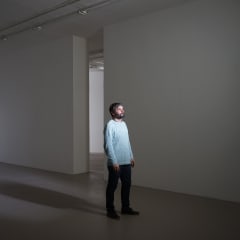This book began to take shape three years ago, first emerging as a publication which would accompany Daniel Steegmann Mangrané’s solo exhibition at The Green Parrot in 2016. Like other exhibition projects at the non-profit project space, the printed matter was set to explore the wider practice of the artist, grounded in, but not limited to the work presented in the show. While configuring the publication we quickly realized it would be impossible to fit all the desired materials into such a small reader. One reference would pull in another, and the network of elements rapidly surpassed what we originally had in mind. A new expanded form for the object was agreed which would overcome the time-space of the exhibition. It would be a compilation of materials built out of a number of influential texts and sets of images illustrating important exhibitions, projects, and works. In this sense the publication asks the readers to build their own understanding of the work out of the collected materials. It is our aim to map a core part of his practice and we hope that its publishing time allows for enhanced readings that will navigate around philosophy and anthropology. What we now have in our hands is therefore the result of an shape-shifting development at once designed and opened to change, an organic process where the mechanics echo the work of Steegmann Mangrané. As a whole, the publication intends to present an essential constellation of Steegmann Mangrané’s universe.
The first pages present five poems by Stela do Patrocínio. Born in Rio de Janeiro in 1941, she was never considered to be a poet and was abandoned by her family at the Colônia Juliano Moreira mental hospital until her death in 1997. Do Patrocínio’s poetic manner impressed different artists that recorded her words and which were later transcribed in a book by Carla Guagliardi named “Reino dos animais e dos bichos é meu nome” [“Kingdom of all the animals and all the beasts is my name”]. It was Guagliardi who introduced Steegmann Mangrané to make use of Patrocínio’s poems. If we follow the poem’s sentences and repetitions, we enter into a thinking process where there is no distinction between human and non-human, matter and form. The poet saw things from a perspective different from the norm, maybe due to her supposed illness or maybe words just formed that way in her mind. In any case, we believe those poetic relations coincide or at least are very close to ideas artists and thinkers have been exploring in the recent years. One of such conceptions is expressed by the phrase “Did not want to have human form, human flesh or human matter”, which became the title of Steegmann Mangrané’s exhibition at The Green Parrot. The first question that comes to mind while reading such a phrase might be ‘what sort of being is talking?’. Do Patrocínio’s words remind us of Roger Callois: where is the limit between the body and the world since the world is all flesh? Where in the body are we to put the seer, since the body is only “shadows stuffed with organs,” that is, more of the visible?
At The Green Parrot, five poems were printed directly on the white walls of the space and fragmented by geometric designs resembling the Steegmann Mangrané’s collage Kiti Ka’aeté (2011). The viewer had to literally adopt different positions or perspectives in order to read them, turning their head to one side or the other. They were also in the original Portuguese, so Spanish readers could interpret most of the text, but most words kept an open and imprecise definition. Some double meanings like the verb “formar” which can mean to create/produce or to shape something but also to be educated. Or beautiful abstract thoughts such as “to be pure air, empty space and time”, are clear examples of the poem’s renewed field of signification. The conjunction of such intellectual and physical playful appropriation of the poems, which expands their open-ended features, enacts Steegmann Mangrané’s conception of life, in which stable conditions or meanings are replaced by a framework of permanent becoming bringing to mind Willen Flusser or Merleau-Ponty’s haunting thoughts which question clear cut and established boundaries.
These poems are employed as an introduction to the artist’s universe, in which everything is entangled and permanently evolving as it is in the jungle, a recurring concrete and symbolical reference. Likewise, they also offer reflections about the organic structure of our planet, a condition we are progressively becoming more aware of through a renewed consciousness of our position as part of an enlarged ecology of agencies not all defined by human features. Drawing from indigenous cosmological believes, Eduardo Viveiros de Castro’s perspectivism reflects on such an expanded non-hierarchical conception of the world and has been a longstanding influence for Steegmann Mangrané. While surely not constituting an exhaustive and concluding portrait of the artist’s practice, this book aims to present a solid sample of the artist’s conceptual universe by pairing images with texts, which do not analyse the artist’s practice rather build an expanded system of alliances and significations. In this sense, instead of offering a closed interpretation this publication asks the readers to build their own understanding of the work out of the collected materials. Employing a history of abstraction reframed by non-hierarchical and non-humancentric conceptions of the world, the artist’s practice disseminates powerful concepts, images and situations which hold strong reverberations in our current social environments. We conceived of this book as an open map to Steegmann Mangrané’s body of work and we hope our readers enjoy exploring this magical territory.

